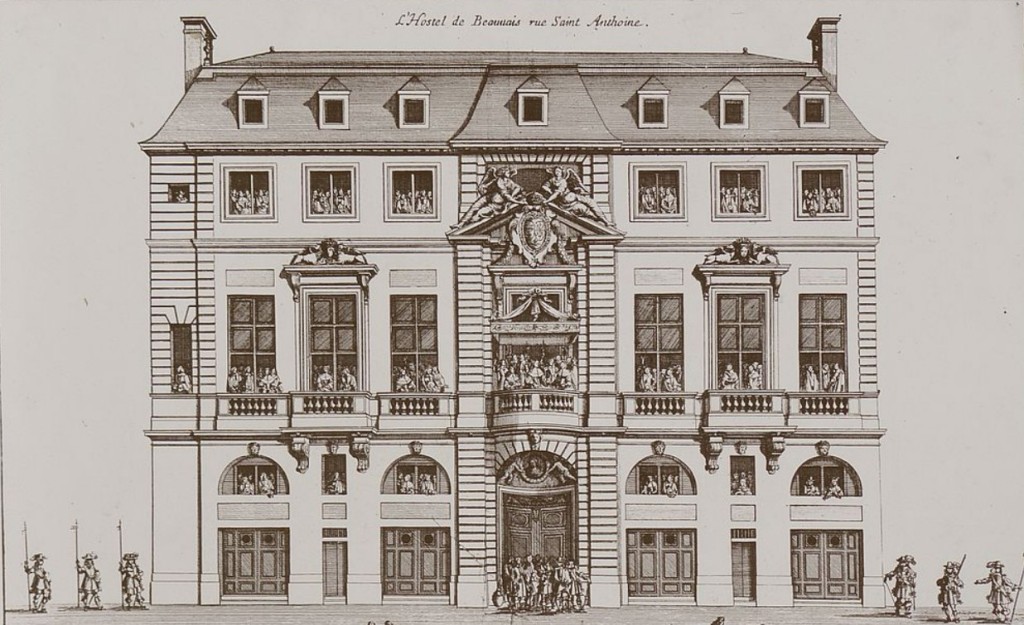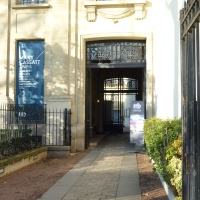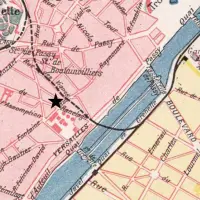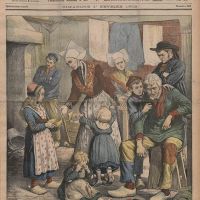When, a few weeks ago, a broadcaster mentioned that Mozart’s mother had died in Paris in 1778, my first thought was: I don’t even know her name! I knew about Wolfgang Amadeus, his hard-driving father Leopold, his gifted sister Nannerl, his long-suffering wife Constanza, all familiar names, but I didn’t know his mother’s name. It’s Anna Maria (although in some biographies, she is called Maria Anna). Her maiden name was Pertl and she was born near Salzburg in 1720.
Wolfgang Amadeus was her seventh child, born in 1756, but only the second to survive infancy, after Nannerl, five years Wolfgang’s senior. When the boy’s extraordinary talent declared itself early, Leopold was quick off the mark to showcase it. In 1762, when Wolfgang was six, the whole family, plus a servant, embarked on a tour. The children performed in Passau, Linz, and Vienna, but after impressing the royal family at the Schönbrunn Palace, Wolfgang fell ill. It was no doubt a relief to him to have his mother nearby. Leopold fretted about money; Anna Maria fretted about her son.
When Wolfgang recovered, the family embarked on a more ambitious tour that began in 1763 and would continue for three and a half years. The children performed in 88 cities and towns. Once again, the whole family travelled together. Madame Mozart had to put up with bumpy carriages and frequent breakdowns, constant changes in lodgings, inclement weather, the stormy moods of her husband, and the care of two precocious children, but we’ll never know much about it. As one Mozart biographer noted, “Leopold kept up a steady stream of letters to [his landlord and financial backer] Hagenauer…[but] there is barely a word in his letters about his wife.”*
We do, however, have one detail. On tour, Madame Mozart and Nannerl shared a bed, and Leopold and Wolfgang shared another.
The family reached Paris in November 1763. But a picture of “the Mozart family” shows three people only: Leopold, Wolfgang and Nannerl. Hmph.
The family lodged with Count van Eyck of Bavaria in the Hôtel de Beauvais on the rue François Miron in the Marais (the building is now the administrative court of appeal). Leopold was pleased about saving money on hotel bills. The children performed at Versailles for King Louis XV and his wife. The queen spoke fluent German and made the family feel welcome.

Both Wolfgang and Nannerl fell ill in Paris, adding to the strain on Madame Mozart, but they recovered and went on to London, crossing the Channel in a small boat with a fraction of their voluminous luggage (the rest stayed in Paris). All four were seasick. The family ended up staying in England for more than a year. They went to The Hague in July 1765, and there, in September, Nannerl became so ill that the doctors told Madame Mozart to prepare for the worst. A priest was summoned to administer the last rites. Anna Maria and Leopold took it in turns to watch over their daughter.
But Nannerl recovered. In December it was Wolfgang’s turn to sicken and hover for some days at death’s door, unable to walk or to speak. Eventually he recovered, too. Biographers suggest that it may have been typhoid fever that afflicted the children. By the end of January, they were back on stage. The show must go on. Leopold insisted.
Since Leopold rarely mentioned Anna Maria, it is possible she, too, had periods of illness, but we’ll never know. Or possibly she had a strong constitution and just carried on.
The family returned to Paris in May 1766 and spent two months there before touring through cities in France, Switzerland, and Germany. When they returned home to Salzburg, friends noticed that 10-year-old Wolfgang had grown very little during his time away. The travelling and the illness had taken a toll.
A planned concert in Vienna was cancelled when the Emperor Franz died and the court was plunged into mourning. Then a smallpox epidemic broke out, affecting both the royal family and the Mozarts. When the children finally performed before the widowed, black-clad Empress Maria Theresa (Marie Antoinette’s mother, shown below), the Empress and Madame Mozart held hands and talked about their children.
Between 1769 and 1772, Leopold and Wolfgang made three trips to Italy, leaving Madame Mozart and the teenaged Nannerl in Salzburg. I suspect the two women were relieved to have some time to themselves.
When father and son returned, the whole family moved into a more spacious house and actually stayed in it for two and a half years. Leopold, after all, was employed by the Archbishop of Salzburg and had duties to perform. And when a patient and supportive archbishop died and was replaced by a stern, non-nonsense cleric, Leopold’s freedom to come and go was curtailed.
This caused a dilemma. Wolfgang needed to be out in the world, not in a provincial city. He was 21 and it was time for him to find a permanent job to support himself. Leopold could not leave Salzburg, and he wasn’t sure that Wolfgang could manage the logistics of travel, music-making, and job-hunting, so the task of accompanying him on the next trip fell to Anna Maria.
Off they went on 23 September 1777. Leopold did his best to micromanage from a distance, sending dozens of letters with instructions and advice. Visit this person. Play such-and-such for so-and-so. Make sure the hotel servant uses boot-trees. They travelled via Augsburg and spent time in Mannheim, where Mozart acquired a girlfriend (the sister of the woman he later married), but not a job.
In March 1778, they continued to Paris. At first, they lodged in a gloomy space in the rue Bourg l’Abbé over the premises of a German-born “fripier” (bric-a-brac merchant).

Wolfgang was not happy. He missed his girlfriend, the streets were filthy, hired carriages were expensive, people were unwelcoming, and he struggled with the language. Madame Mozart spoke no French at all. And she didn’t like the food.
The two eventually found better lodgings at 8 rue du Sentier (shown as rue Centier in the Turgot map below) in what is now the 2eme arrondissement. The premises are now called Maison Mozart and there is a plaque on the wall. As the weather warmed up, life improved and Madame Mozart wrote to Nannerl about Paris fashions. Wolfgang had a few students, some new friends, and a job offer as an organist that he turned down.
But in June 1778, Madame Mozart fell ill, with a fever and a headache. She wrote to her husband about having a sore throat and earache. Leopold responded with Useful Advice (have a doctor bleed you). She did and it made her feel worse. So she stopped talking about how she felt. Her final letter is filled with cheery descriptions of Paris and a brief mention of being tired after visiting the picture gallery at the Luxembourg Gardens.
Madame Mozart was reluctant to have a French doctor see her. She may also have been worried about the expense of a doctor (Leopold was forever harping on about money and expenses). Wolfgang located a German doctor, who treated her with “rhubarb powder in wine.”**
On June 30, last rites were administered and Anna Maria Mozart died on the evening of July 3. Again, the disease may have been typhoid fever. As one biographer notes, “Water may have been the culprit; the Parisians never drank it, but the Mozarts had done so, unsuspectingly, wherever they were.”*** The very next day, she was buried at the church of St-Eustache, which at the time had a churchyard (it has since disappeared, but she is commemorated on a plaque inside the church).

Oddly, Mozart wrote to his father immediately after his mother’s death to say that she was ill, but not that she had died. He wrote another letter to a friend, telling the truth, and asking the friend to prepare Leopold and Nannerl for bad news. About a week later, he finally broke the news to his father. When Leopold wrote back, blaming Wolfgang for her death, Mozart stopped writing for a while.
The Mozarts were a complicated family. They were close, but often at odds. Leopold controlled his children’s lives so rigidly that his son never developed the skills he needed for seeking and retaining steady work. And far too little is known of the woman who held the family together and looked out for the children’s welfare, nursing them through their illnesses, and probably keeping their lives moderately sane during unbelievably prolonged and stressful travels.
When we are next in Paris, I shall stop by St Eustache and pay my respects to Madame Mozart. And I shall address her by name.
* John Suchet, Mozart: The Man Revealed (New York, Pegasus Books, 2017), p. 31.
** Stanley Sadie, Mozart: The Early Years, 1756-1781 (New York: Norton, 2006), p. 459.
*** Roye E. Wates, Mozart: An Introduction to the Music, the Man, and the Myths (Milwaukee: Amadeus Press, 2010), p. 107.
Text by Philippa Campsie, postcard from our collection, other images from Wikimedia and Google Street View.


























Thank you, Phiippa! This was most interesting. Their lives were difficult indeed.
God bless, C-Marie
I don’t know how they managed. It is amazing the children survived those arduous travels.
Haha… Philippa, I KNEW you penned this fascinating post when I came across the “hmph”!!! Hope you two are well. It would be SO lovely to have a get-together this spring! Xx Nicola
Yes, indeed. Our last get-together seems so long ago. Let’s arrange something in March.
Thank you so much for sharing this…..fascinating! Olive
So glad you enjoyed it.
Well that was interesting!! Makes me wonder what happened to the churchyard where she was buried? Did Paris just build over the top of it? Were the graves dug up and just disposed of? They wouldn’t do that, right? Or would they?! I remember when studying Marie Antoinette that she and Mozart were close in age and friends in childhood. Never did I go on to actually learn about his history.
The bones from the cemetery were removed to the Catacombs. This happened less than ten years after Madame Mozart’s death. She was in good company, as Couperin and Moliere were also in the same cemetery.
Fascinating story about a famous family I knew so little about.
Until I wrote this, I didn’t know very much, either. I’ve always felt that it is pointless to “write what you know.” It’s much more fun to “write what you want to know about”!
Thanks, Philippa, for another fascinating story. We are staying in an apartment in the 2nd arr. on our next trip and will definitely visit St Eustache.
Marsha Huff
I must have passed that church dozens of times, but I don’t think I have ever been inside it before.
Supposedly the picture of ‘The Mozart Family’ was made as a promotional sort of poster. Several copies were printed and posted about like a flyer announcing a performance. Maybe Frau Mozart was not in the picture simply because she did not perform.
That’s a very good point. Thank you.